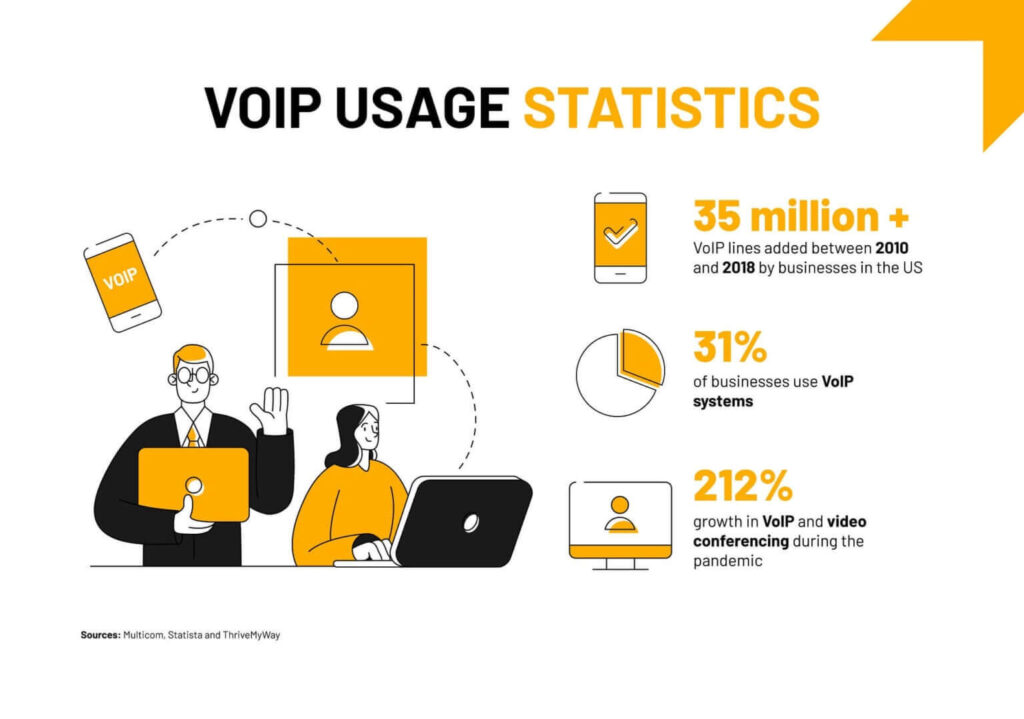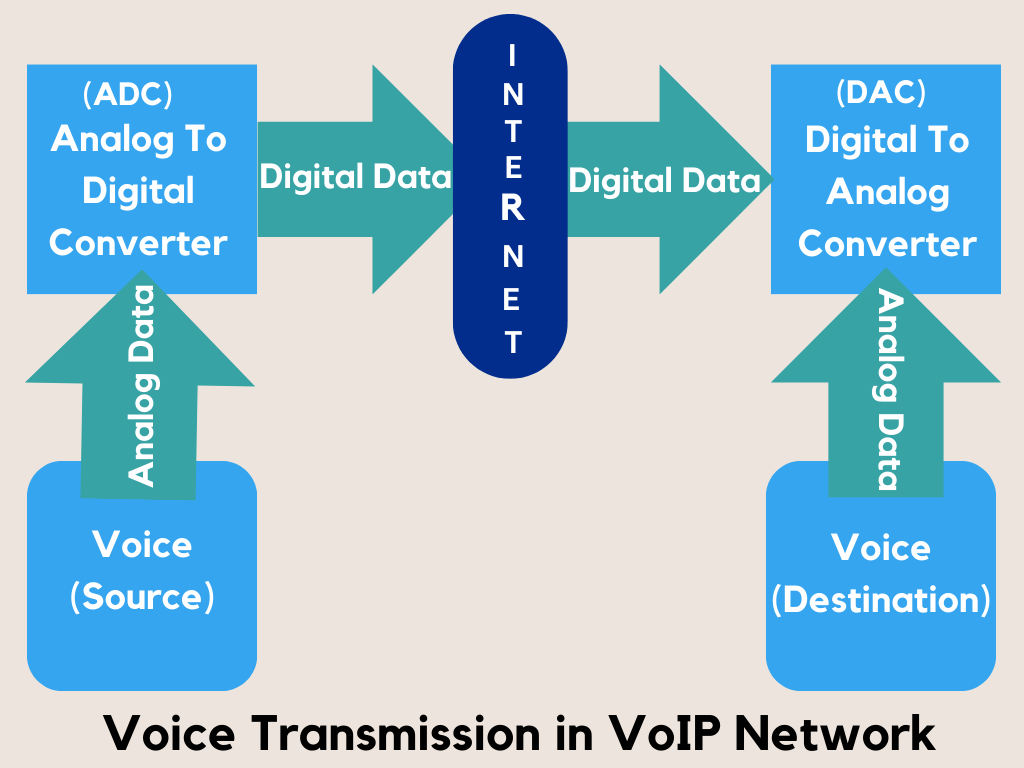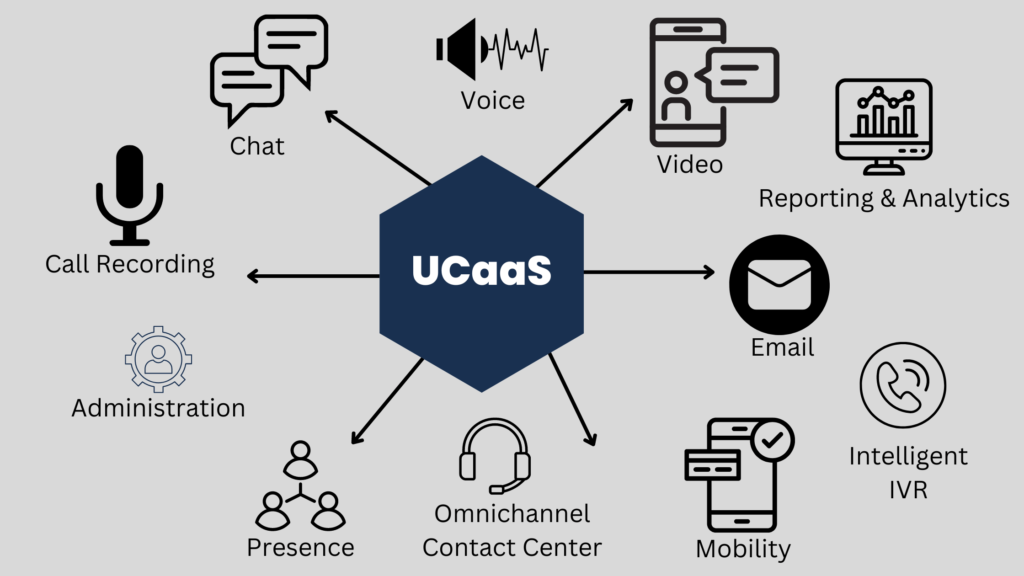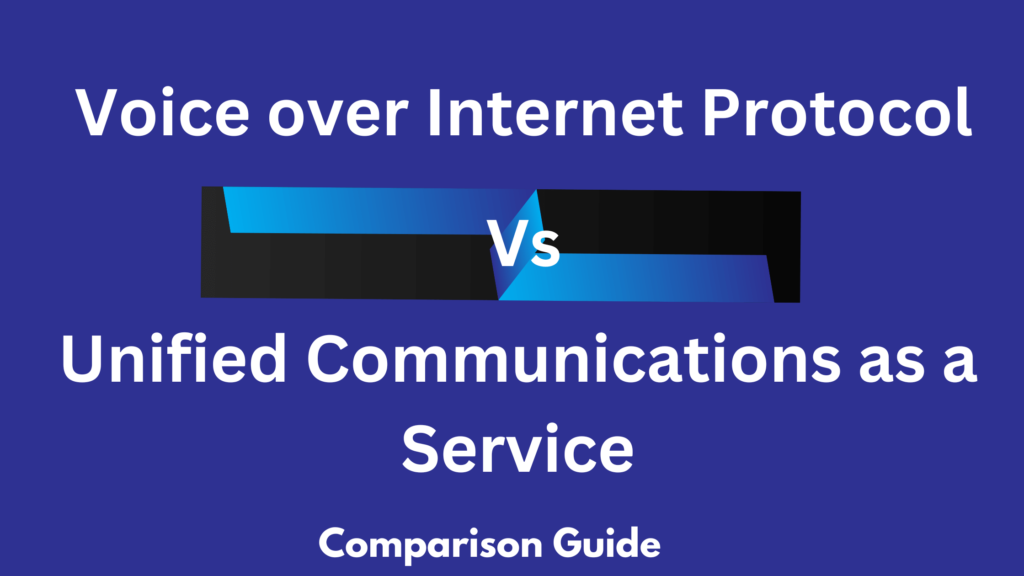In today’s business space, clear and efficient communication solutions are essential. Voice over Internet Protocol (VoIP) and Unified Communications as a Service (UCaaS) represent two significant advancements in telecommunication technologies. Each system offers distinct features and benefits, catering to varied business needs.
This blog provides a brief comparative analysis, explaining the fundamental differences between VoIP and UCaaS, thus enabling your businesses to make informed decisions when choosing a communication solution.
Table of differences between VoIP and UCaaS
Feature | VoIP | UCaaS |
Definition | Technology that enables voice calls over the Internet. | Comprehensive communication and collaboration services delivered as a cloud-based solution. |
Scope | Primarily focused on voice communication. | Encompasses a broader range of communication services, including voice, video, messaging, and collaboration tools. |
Components | Typically includes IP phones, softphones, and a VoIP service provider. | Incorporates a suite of communication and collaboration tools such as voice, video, chat, presence, file sharing, and more. |
Deployment | Can be implemented on-premises or through a hosted service. | Generally delivered as a cloud-based service, although some UCaaS solutions may offer hybrid or on-premises options. |
Scalability | Scales well for voice services. | Highly scalable, with the ability to easily add or remove users based on organizational needs without significant infrastructure adjustments. |
Integration | Integration with other collaboration tools may need additional configuration. | Designed for seamless integration between different communication and collaboration features, offering a unified experience. |
Cost Structure | Generally focused on per-minute or per-line charges for voice calls. | Subscription-based model, often with predictable monthly costs, covering a range of communication and collaboration services. |
What is VoIP
VoIP refers to the suite of technologies, protocols, algorithms, and hardware that enable voice conversations over the Internet. VoIP converts sound into data and transmits it like any other type of data over the internet. It offers a cost-effective way to make calls, with advanced features and functionality that traditional phone systems cannot match.
VoIP communication operates using internet connectivity and can include more than just voice – it can handle multimedia communication, such as video and web conferencing. This adaptability makes it highly suitable for modern work environments and integrated business systems. Around 31% of businesses currently employ VoIP systems, according to statistics.

Two types of VoIP
There are two primary types of Voice over Internet Protocol:
Fixed VoIP
Fixed VoIP services are linked to a physical location, providing enhanced security and serving as an ideal solution if your business looking to integrate its VoIP system with its existing office infrastructure.
Non-Fixed VoIP
Non-Fixed VoIP, in contrast, is not tied to a physical location. This model offers unmatched mobility, allowing you to make and receive calls from any location with an internet connection, making it a perfect fit for remote teams and telecommuters.
Related Reading:
How does VoIP communicate
VoIP converts the human voice into data packets, which are then transmitted over an IP network and ultimately reassembled into the original audio at the recipient’s end. The process begins with the analog voice signal being converted into a digital format via an analog-to-digital converter.
The digital signal is then divided into data packets, each of which contains a portion of the voice signal as well as header information, crucial for routing the packets to the correct destination over the network.
After the packets arrive at their intended endpoint, the packets are systematically reordered to ensure the original sequence. After which a digital-to-analog converter restores the voice signal to its original form, making it audible to the receiver.

Here are the key operational steps of VoIP in simple terms:
- Voice Signal Capture: The speaker’s voice is picked up by a microphone.
- Digitization: This analog signal is then converted into a digital format.
- Data Packetization: The digital voice data is encapsulated into packets suitable for internet transit.
- Transmission: These packets are sent over the IP network to the intended recipient.
- Reassembly: The received packets are put back together in the correct order.
- Voice Reconstruction: Finally, the packets are decoded back into an audio signal for the recipient to hear.
Through this sequence of steps, VoIP enables seamless voice communication over the Internet.
Benefits of VoIP
VoIP offers a range of advantages that can be crucial if your business is looking to enhance its communication capabilities. These benefits include:
- Cost Efficiency: VoIP services generally incur lower costs than traditional phone systems, primarily due to the utilization of existing internet infrastructure which eliminates the need for separate phone lines. In fact, switching to VoIP can result in a reduction of monthly telecom expenses by up to 50% for companies.
- Flexibility and Scalability: It allows for easy addition or removal of phone lines to match your business growth or scale down when needed, without significant changes to the existing setup.
- Enhanced Functionality: Beyond voice calls, VoIP systems often integrate additional features such as voicemail, call forwarding, caller ID, and conference calling without requiring extra hardware.
- Portability: The system allows your employees to make and receive calls from any location with internet access, promoting remote work and consistent communication across different locations.
- Improved Voice Quality: With a stable internet connection, VoIP can provide superior voice quality compared to traditional analog phone lines.
Related Reading: Pros and cons of VoIP
Features of VoIP
- Instant Messaging: The Instant Messaging feature facilitates quick and efficient communication, allowing real-time exchanges of information. With Instant Messaging, your team members can easily collaborate, share ideas, and seek feedback, developing enhanced productivity and streamlined workflows.
- Automated Attendants: With automated attendants, your business can provide a seamless calling experience for your customers, ensuring that their calls are routed to the right department or individual with ease. These attendants are equipped with advanced features such as customizable greetings, call forwarding, and menu options, enabling you to create a professional call-handling system.
- Call Recording: By utilizing call recording functionality, you can capture and store audio recordings of your calls, enabling you to ensure quality assurance and conduct effective training sessions. With the ability to review and analyze these recordings, you can pinpoint areas for enhancement and provide training to your team, enabling them to deliver superior customer experiences.
- Voicemail-to-Email: By converting voicemails into easily accessible emails, this feature streamlines communication and eliminates the need for traditional voicemail retrieval methods. With Voicemail-to-Email, you can conveniently listen to voicemails directly from your email inbox, ensuring efficient and timely access to important messages. Whether you’re in the office or on the go, this feature lets you stay connected and responsive, enabling you to manage your communication needs.
- Call Analytics: By extracting valuable insights from comprehensive call data, your business can gain a deeper understanding of customer interactions and make more informed strategic decisions. With Call Analytics, you can analyze call patterns, identify trends, and uncover actionable intelligence to optimize performance, enhance customer satisfaction, and drive business growth.
- API Integration: With advanced API integration capabilities, you can effortlessly connect your VoIP system to customer relationship management (CRM) platforms, project management tools, help desk software, and more. This deep integration empowers your team to access and manage communications directly within their preferred business applications.
What is UcaaS in simple terms?
Unified Communications as a Service (UCaaS) is an integrated approach to communication that combines various messaging tools and applications under a singular cloud-based platform. This model facilitates real-time collaboration and a seamless communication experience across multiple channels.

Between 2022 and 2030, the worldwide UCaaS market is anticipated to achieve a compound annual growth rate (CAGR) of 10.2%. (Source)
Key elements of UCaaS include:
- Voice and telephony, including VoIP (Voice over Internet Protocol).
- Meeting solutions, such as video conferencing.
- Messaging, which covers text-based communication like chat and SMS.
- Mobility features, allow users to access services from any device.
How does UCaaS work
Unified Communications as a Service (UCaaS) is a comprehensive communication solution that integrates various communication tools into a single platform. UCaaS operates from a centralized cloud-based platform.

This centralization simplifies the process of connecting to communication tools, as you can access them from any location with the internet. The platform is hosted and maintained by a third-party service provider, relieving organizations of the responsibility of managing and maintaining on-premises infrastructure.
In addition, Voice over Internet Protocol (VoIP) is a core component of UCaaS. The platforms often include VoIP capabilities, allowing users to make voice calls, conduct conference calls, and access features such as voicemail and call forwarding.
Features of UCaaS
- Messaging: The UCaaS system offers instant messaging and presence technology, allowing you to send real-time messages and easily check the availability of your colleagues. This helps to facilitate quick and efficient communication within the organization.
- Mobility: With the UCaaS system, you can access and utilize its features from any device, whether it’s a laptop, smartphone, or tablet. This ensures that communication remains consistent and uninterrupted, regardless of your location or the device they are using.
- Integration: The UCaaS system seamlessly integrates with other business applications and systems, enhancing workflow and productivity. This means that you can easily access and utilize the UCaaS features within your existing applications, without the need for switching between different platforms.
- Video Conferencing: The UCaaS system offers high-definition video meetings with advanced screen-sharing capabilities. This allows for more effective and engaging collaboration, as participants can share and discuss content in real time.
- Contact Center Services: The UCaaS system provides advanced features specifically designed for customer service purposes. These features include call queuing, analytics, and interactive voice responses, which help to streamline and enhance the overall customer service experience. With these capabilities, your business can efficiently handle incoming calls, analyze call data, and provide interactive voice prompts for improved customer satisfaction.
- Collaboration Tools: The UCaaS system offers online spaces dedicated to team collaboration. These spaces provide features such as file sharing and joint editing, allowing your team members to easily collaborate on documents and projects.
- Unified Messaging: The UCaaS system provides a single platform that combines voicemail, fax, and email functionalities. This streamlines the messaging experience for users, as you can access and manage all your messages in one place.
Why Switch to UCaaS: The Benefits
- Enhanced Collaboration: UCaaS platforms enable real-time collaboration through features like shared workspaces and tools, essential for remote and hybrid work environments.
- Cost Efficiency: By consolidating various communication tools into a single, cloud-based service, UCaaS typically reduces overhead costs associated with maintaining multiple systems. Research findings also suggest that the utilization of UCaaS systems can lead to businesses saving approximately 30% to 50% of their current operating costs.
- Improved Productivity: The integration capabilities of UCaaS with other business applications streamline workflows, significantly boosting your organizational productivity.
- Improved Customer Experience: The comprehensive communication tools provided by UCaaS facilitate enhanced customer interactions. Businesses can engage with clients through their preferred channels, provide faster response times, and offer more personalized service.
- Regular Updates and Innovation: The cloud-based nature of the service ensures that upgrades and new functionalities are integrated routinely. This process occurs automatically, without the necessity for manual software updates or the deployment of internal IT resources.
“Businesses now have a choice in how to deploy unified communications, including traditional on-premises, hosted and cloud-based deployments. Each of deployment scenarios carries with it varying levels of maintenance and management responsibilities. For on-premises deployment, administration and management falls exclusively internal IT resources, while hosted UC deployments allow a sharing of responsibilities between the business and the provider. Cloud-based UC deployments allow customers to offload management and maintenance responsibilities to the cloud provider.” – Michael Braydenburg, industry analyst, Frost & Sullivan
The main differences between VoIP and UCaaS
VoIP and UCaaS have fundamental differences in scope, deployment, and more. Understanding these distinctions is vital in choosing the system that aligns with your business goals.
1/ Scalability: VoIP systems are typically limited in scalability due to their reliance on on-premises PBX or hosted solutions. This means that as your business grows, you may need more support in terms of adding more users or expanding your communication infrastructure.
On the other hand, UCaaS operates in the cloud, offering virtually limitless scalability. With UCaaS, you can easily scale up or down based on your business needs, without the need for significant infrastructure investments.
2/ Communication Modes: While VoIP primarily focuses on voice calls, UCaaS goes beyond that by encompassing a broader range of communication modes.
In addition to high-quality voice calls, UCaaS also supports video conferencing, instant messaging, chat, and collaborative online workspaces. This means that with UCaaS, your team can communicate and collaborate using the most suitable mode for each situation.
3/ Integration: UCaaS is designed for easy integration with other enterprise applications, making it a powerful tool for streamlining workflows and enhancing productivity. By integrating UCaaS with your CRM, project management software, or other business applications, you can centralize communication and access relevant information without switching between different tools.
In contrast, VoIP usually serves as a standalone or integrated component within a larger UCaaS ecosystem, limiting its integration capabilities.
4/ Cost Considerations: VoIP generally offers cost-effective solutions for simple communication needs. It provides businesses with essential voice communication functionality at a lower cost compared to traditional phone systems.
However, UCaaS offers greater value with its comprehensive suite of features. While it may have a higher upfront cost, UCaaS provides businesses with a wide range of communication and collaboration tools to improve efficiency, enhance customer interactions, and drive innovation.
Similarities between VoIP and UCaaS
While VoIP and UCaaS may differ in their approach and complexity, they also share a common ground that benefits businesses:
1/ Remote Connectivity: Both VoIP and UCaaS enable remote work by enabling your employees to connect from anywhere with an internet connection. This functionality has become essential as the trend of working from home becomes more established.
2/ Enhanced Customer Experiences: By providing advanced features like automatic call routing and call analytics, both platforms enable businesses to optimize their customer interactions, leading to improved customer satisfaction and loyalty.
3/ Quality Enhancement: With proper network conditions and setup, such as using Quality of Service (QoS) configurations, both systems can significantly improve call quality.
4/ Cost Efficiency Over Time: VoIP and UCaaS offer cost savings compared to traditional phone systems, especially with long-term use, potentially reducing operational expenses.
Difference between VoIP and Unified Communication
VoIP, as previously described, is essentially the use of the internet to carry voice calls and multimedia messages. It involves the digital transmission of voice calls using a bandwidth connection, without the additional features offered by Unified Communication.
VoIP is typically used by organizations seeking to upgrade from traditional telephony systems, focusing on voice-based communication.
Unified Communications, on the other hand, goes beyond this singular functionality. UC includes not only voice services but also integrates video conferencing, instant messaging, presence information, and file sharing into an Integrated system.
It allows you to communicate seamlessly across various communication streams within a unified interface, developing enhanced connectivity, and collaborations.
To Know more check out our detailed guide on: Voip and unified communications.
Use Cases and Scenarios for VoIP and UCaaS
When aligning the choice of VoIP or UCaaS with business needs, consider the following use cases and scenarios.
VoIP: Highly Suitable for Cost-Efficient Communication Revamps
- Enterprises Transitioning from PSTN: Organizations moving away from analog phone systems find VoIP to be a cost-efficient substitute offering immediate cost savings and ROI.
- SMEs with Growing Communication Needs: Small to medium enterprises scaling up operations can employ VoIP as a means to introduce more advanced communication without the complexity of a complete UC suite.
- Businesses with Predominant Voice Communication: Companies, where voice calls remain the principal mode of communication, will benefit from VoIP’s advanced call-handling features without the overhead of additional UC functionalities.
UCaaS: Tailored for Advanced Communication Ecosystems
- Corporations Requiring a Comprehensive Toolset: For businesses seeking an all-inclusive communications suite, UCaaS provides everything from video conferencing to real-time collaboration tools.
- Organizations with a High Emphasis on Collaborative Workflows: Companies developing team collaboration on projects can utilize the unified features of UCaaS to enhance productivity and teamwork.
- Industries with Demand for Omnichannel Communication: Customer-facing industries that require consistent and unified communication across multiple channels, such as retail or services, will find UCaaS offers a strategic advantage.
By evaluating these criteria and applying them to their particular operational contexts, businesses can pinpoint which solution—VoIP or UCaaS—will more effectively meet their communication requirements and facilitate their strategic objectives.
Top VoIP providers with UCaaS functionality
When assessing VoIP providers that offer Unified Communications as a Service (UCaaS), it is crucial to consider key players known for their extensive features, dependability, and integration capabilities. The following providers stand out for their combined VoIP and UCaaS offerings:
1/ RingCentral: A prominent player in the UCaaS field, RingCentral offers a comprehensive platform that encompasses VoIP, contact center solutions, video conferencing, and team messaging. It caters specifically to businesses that require a seamless transition between different modes of communication.
2/ 8×8: This provider delivers an integrated cloud communications platform that covers voice, video, messaging, and contact center operations. All these services are unified within a user-friendly and extensible suite.
3/ Cisco Webex: Renowned in the communications industry, Cisco’s Webex offers extensive voice and video features, as well as messaging and team collaboration tools. It provides a comprehensive solution suitable for enterprises of all sizes.
4/ Mitel: Mitel’s UCaaS solutions are designed to cater to a wide range of industries, offering tailored features including business VoIP, contact centers, and collaboration tools. These features are all aimed at supporting integrated communication strategies.
5/ Microsoft Teams: While traditionally recognized for its collaboration capabilities, Microsoft Teams now includes VoIP services. It seamlessly integrates with Office 365 applications and provides a unified communication and collaboration environment.
6/ Vonage: Vonage provides a cloud-based platform that supports a suite of communication features, ranging from voice and video to messaging and contact centers. This makes it ideal for dynamic business environments.
VoIP Vs. UCaaS: Which one is the right solution for your business
When it comes to deciding between VoIP (Voice over Internet Protocol) and UCaaS (Unified Communications as a Service), it’s important to carefully consider the specific requirements and situation of your business.
If your priority is cost reduction and a straightforward communication experience, VoIP might be the suitable option. With VoIP, you can enjoy the benefits of using your existing internet connection to make and receive calls, resulting in potential cost savings.
However, if you’re looking for a more comprehensive solution that offers advanced collaboration tools and features, and you’re willing to make a higher initial investment, UCaaS could be the ideal choice.
UCaaS brings together different ways of communicating—phone calls, video chats, texts, and meetings—into a single, easy-to-use cloud service. It also includes useful features like showing if someone is free to talk and works smoothly with other business software.
By opting for UCaaS, you can empower your team with enhanced productivity and seamless collaboration, ultimately driving your business toward success.
Frequently Asked Questions:
Q1) What is VoIP and UCaaS?
Ans: Voice over Internet Protocol (VoIP) is a technology that enables voice calls by using the Internet as the medium for transmission, rather than traditional telephone lines. In simple terms, VoIP takes your voice, turns it into digital data, and sends it over the internet, allowing for telephone calls to be made from computers, or VoIP phones.
UCaaS (Unified Communications as a Service) extends beyond VoIP by providing a comprehensive suite of communication services such as voice, video, messaging, and collaboration functionalities, all delivered over the Internet and accessible via various devices.
Q2) What is the difference between SIP and UCaaS?
Ans: SIP (Session Initiation Protocol) is a signaling protocol used to initiate, maintain, and terminate real-time sessions that include voice, video, and messaging applications. SIP is an integral part of implementing VoIP but does not include the full range of services that UCaaS offers.
UCaaS integrates multiple communication and collaboration services into a single, cohesive experience. It incorporates SIP as part of its technology stack to establish voice-over IP communications but adds layers of services on top, making it a more versatile and holistic communication solution.
Q3) What is the difference between VoIP and SIP?
Ans: The main difference between VoIP and SIP is that VoIP refers to the actual transmission of voice communications over an IP network. It is the broad technological approach that encompasses various types of voice communications via the Internet.
SIP, on the other hand, is a protocol that specifically enables VoIP features. It is part of the underlying framework that facilitates VoIP communications but does not represent the full range of capabilities that VoIP provides.
In contrast, SIP—Session Initiation Protocol—is specifically designed to enable and support VoIP functionalities. It forms an integral part of the VoIP framework, facilitating the initiation, management, and termination of VoIP communication sessions.
Q4) What is the difference between PBX and UCaaS?
Ans: Private Branch Exchange (PBX) is a dedicated telephone network used exclusively within an organization. Traditional PBX systems require on-premise hardware to route calls and provide telephony features.
UCaaS (Unified Communications as a Service) takes this concept further by hosting these functionalities in the cloud, eliminating the need for extensive on-premise hardware.
UCaaS offers a broader range of communication tools compared to a traditional PBX system, which primarily focuses on voice communication.

